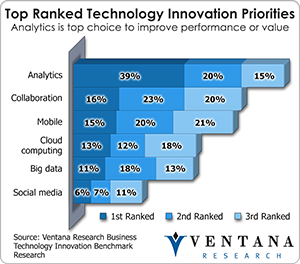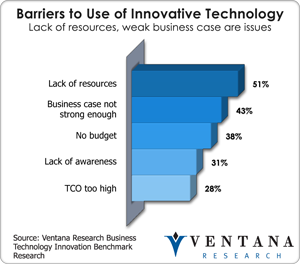Information technology for business is changing rapidly as organizations demand innovation to help them discover insights and facts. Our research into business technology innovation found analytics to be the top priority in 39 percent of organizations. Businesses feel pressure to be better, faster and smarter in operating processes, and understanding their various types of information is a key to success. Businesses are looking to capture value from all types of information both within the enterprise and on the Internet. In this context technology providers are now using the term “discovery” to capture potential buyers’ attention; it became an area for technology spending in 2012 and likely will be for years to come. In fact my colleague Tony Cosentino has identified discovery as one of the four pillars of big data analytics.
top priority in 39 percent of organizations. Businesses feel pressure to be better, faster and smarter in operating processes, and understanding their various types of information is a key to success. Businesses are looking to capture value from all types of information both within the enterprise and on the Internet. In this context technology providers are now using the term “discovery” to capture potential buyers’ attention; it became an area for technology spending in 2012 and likely will be for years to come. In fact my colleague Tony Cosentino has identified discovery as one of the four pillars of big data analytics.
Discovery is one of many business analytics methods that can be used realize value from current and future investments into big data. Discovery, of course is the act of finding something, whether it’s truly new or just overlooked. Wikipedia adds, “With reference to science and academic disciplines, discovery is the observation of new phenomena, new actions or new events and providing new reasoning to explain the knowledge gathered through such observations with previously acquired knowledge from abstract thought and everyday experiences. Visual discoveries are often called sightings.”
In business the knowledge gathered by individuals engaged in discovery is critical to provide context; typically those people are analysts responsible for the organization’s analytics or increasingly are business professionals competent to delve into the discovery process; for either, analytic technology should provide meaningful information in dynamic fashion. Done right, discovery produces intelligence, and analytic tools have improved the usability that enables more people to discover insights using this class of technology. I have already pointed out why conventional business intelligence is failing business; improving on these failings should also be a guide to what we need from discovery technology. With the wide adoption of big data technologies in varying approaches, organizations need to find the right tools to take advantage of it, but adequate data and visual discovery are not currently available in almost one-fifth (19%) of organizations participating in our technology innovation research.
There are four main types of discovery for business analytics: in no particular order, they are event, data, information and visual. Let’s consider each of them and the potential they hold for realizing full value from business analytics and big data investments.
Event Discovery: Enterprise networks now must handle extreme velocity in the streams of events that pass into and through them. If they are processed effectively, discovery through analytics could reveal current bottlenecks and opportunities for improvement or if trended and projected could indicate patterns developing in a negative direction. Processing events in a real-time or right-time manner has evolved from complex event processing into a category of its own, operational intelligence. Our research in this area found that nearly half (45%) organizations consider it very important to analyze business and IT events, and another 44% indicated it is somewhat important. The process of discovery applied to events can take many directions; for example, discovery analytics can immediately notify someone to take action, or the results can be displayed visually to make it easier to identify outliers or trends that should be further analyzed for review. As well, discovering relationships between events is very important to 53 percent of organizations. But the right tools are necessary for success. Our research shows that the large majority (91%) of organizations that use specialized tools for this are satisfied with them, compared to 76 percent that use general-purpose BI tools. The role of event discovery, now being called big data in motion, is changing rapidly as Tony Cosentino has pointed out.
Data Discovery: Enterprise databases contain ever larger volumes of structured data that describe transactions and interactions with their customers, their products and employees, the locations where their business operates and relations with their partners and suppliers. This kind of data is significant and can be sourced from in-house business applications and data warehouses and from software rented in the cloud computing environments, as well as through new investments in big data. From whatever source, having more interactive and data-centric discovery is critical to empower analysts and even data scientists. Data discovery is not new, but it has evolved greatly. Intuitive and flexible a new tools have advanced from the foundation of OLAP to perform data discovery on large volumes of source data and place it into a business model or analyze it while still in its almost original formats. The ability to combine and relate data from Internet sources expands the realm of what is possible to know and act on while expending less time and resources. Many business intelligence suppliers are just beginning to see what is required to meet the needs of today’s analysts compared to the past needs of IT or BI professionals needs to publish reports and dashboards. Our research finds that exploring data underlying analytics in a discovery manner is a critical business analytics need in 37 percent of organizations. Some new big data-oriented analytic tools can do more comprehensive data discovery, and IT departments will have accommodate them to provide what analysts need to do their jobs.
Information Discovery: Organizations now must handle a broader variety of information than ever before, including documents and semi-structured content whose data is not contained in a database. This wealth of information provides an opportunity to increase business understanding, but users need to access and integrate it for a range of tasks such as fraud, risk and compliance; process improvement; and reporting and analytics. This information can also be combined with data from databases to provide a comprehensive foundation for applying discovery processes. Our research shows that content is the second-most important type of data in 59 percent of organizations, right after customer data (71%). We believe that information optimization is a key benefit of big data and information management investments, but as I have pointed out it requires flexible technology to utilize all this information. Information discovery was once left to very expensive technology and specialized resources, and hence was beyond the reach of many organizations. Now many vendors offer tools that can perform content analytics to discover key information in proprietary formats and harvest it for business operations. The new generation of tools also provides the ability to define templates and placement for information to be integrated without the work of developers; it can analyze the layouts of documents and process their contents on an automated basis.
Visual Discovery: This is the latest technology craze as analysts clamor to add it to their analytic tool sets. Our research finds that presenting data visually is the second-most demanded critical business analytics capability for 48 percent of organizations. This type of discovery helps visualize large volumes of data to add new focus to finding areas of opportunity and challenges. Visualization may seem deceptively easy, but it is actually quite difficult to design technology that a range of nontechnical roles find easy to understand and present. I have seen vendors just attempt to lay more sophisticated visualization on top of their existing products, but doing this does not produce the usability and interactivity users insist on; lacking these qualities has severely hindered adoption. Being able to use visualization as a selection method for further discovery dramatically reduces the time it takes users to analyze data and find new insights. At some point in the visual discovery process, users want to share a visualization or a chart for further collaboration, to identify potential places for root-cause analysis or to make recommendations for resolution. At this point in development, however, most of the technology in visual discovery is not able to easily associate comments or bullets to a specific view and then enable sharing or collaboration on it electronically.
Not all discovery technology is created equal, as my discussion of the four big types of discovery shows. Some tool providers excel at one type, but few do all of them well. Thus your organization will have to create a discovery strategy as part of your business analytics efforts and choose and budget appropriately as you identify your most critical needs. You certainly will need to do something: Our business analytics research finds that analysts in 42 percent of organizations spend the majority of their time on data-related activities instead of actual analysis, so it is vital to reduce these chores and that ensure discovery methods do not increase that time; have IT staff automate these tasks through data integration and virtualization. For the CIO, it is important to ensure you are not just investing into evolution of your business intelligence tools as Tony points out; remember that the priority now is meeting the needs of the business and especially the analysts who are held responsible for analytics. Just serving reports and dashboards faster and in prettier form in many cases is not going to provide the critical insights. As I have already pointed out, putting more charts in dashboards or embedding key performance indicators are not smart strategies for guiding business improvement.
There is work to do here in convincing skeptics of the need for investment. According to our business technology innovation research building the business case (43%) is the second-greatest t barrier to adopting innovative technology like discovery, following lack of resources (51%). It is not easy to use a traditional business case that projects value and benefits from a specific investment in the case of discovery, where the technology is about finding the unknown and providing benefits depends on the competency and skill of your analysts and business professionals as well as the effectiveness of the technology. Because usability is critical (the evaluation category criteria most often classified as important by 64% of organizations in our research) you must look beyond just the capabilities in the technology to how easily a variety of roles can use it and collaborate on the insights found from it. Most tools are only suitable for certain roles and maybe not for every analyst, let alone directors or vice presidents. These innovations by many technology vendors are just coming to market. Many organizations decide the potential value of an investment on the time to utilization of the tool and the projected time to value on potential insights from it; for analytics through discovery that is not always easy today.
According to our business technology innovation research building the business case (43%) is the second-greatest t barrier to adopting innovative technology like discovery, following lack of resources (51%). It is not easy to use a traditional business case that projects value and benefits from a specific investment in the case of discovery, where the technology is about finding the unknown and providing benefits depends on the competency and skill of your analysts and business professionals as well as the effectiveness of the technology. Because usability is critical (the evaluation category criteria most often classified as important by 64% of organizations in our research) you must look beyond just the capabilities in the technology to how easily a variety of roles can use it and collaborate on the insights found from it. Most tools are only suitable for certain roles and maybe not for every analyst, let alone directors or vice presidents. These innovations by many technology vendors are just coming to market. Many organizations decide the potential value of an investment on the time to utilization of the tool and the projected time to value on potential insights from it; for analytics through discovery that is not always easy today.
To evaluate the benefits of the new generation of business analytics that utilize the discovery methods discussed here, start with a conversation internally to identify your needs and look at some online demos to see what is possible. Our next-generation business intelligence research finds discovery to be a critical consideration for 69 percent of organizations, which indicates the strong interest in discovery technology that will work for business and IT. From another perspective, our spreadsheets in the enterprise research finds that 74 percent of organizations are still using personal spreadsheets with BI to meet many of their data and visual discovery needs, at the same time as 56 percent find it time-consuming to combine spreadsheets through copying and pasting and more than one-third (35%) find data errors from their use of spreadsheets. As my colleague Robert Kugel puts it, it is time to end denial about the use of spreadsheets and focus on buying tools designed for complex tasks like discovery. For IT organizations, it is essential to address data and integration needs for analytics and analysts so business is not spending so much time on data-related tasks; they also should understand that while there will be more tools and vendors in use, the architecture and support of them should be simplified. For business, it is critical to understand what the types of discovery are all about and where technology innovation in 2013 can help make your organization’s processes run better and faster. It will be well worth your time to investigate why more organizations – and maybe your competitors among them – are getting benefits from making their business to smarter by using discovery.
Regards,
Mark Smith
CEO & Chief Research Officer













